 I am building a portable bluetooth speaker. I am using 4 18650 Li-Ion batteries and using 4S 14.8v BMS/PCM charge/discharge protection board with balancing. This board works great, but the challenge is when the board goes into "protection" mode you have to apply voltage to it to launch the device. This means that I have to connect speaker to my 15v power supply, close s1, s2 and s3. Once I see that the amplifier is working I can unplug the power supply and use the device as portable running on batteries. This is a requirement even when the batteries are fully charged (please see diagram). Is there a way to avoid having to apply power supply voltage to launch this BMS? If not, are there other boards that have better design for this application?
I am building a portable bluetooth speaker. I am using 4 18650 Li-Ion batteries and using 4S 14.8v BMS/PCM charge/discharge protection board with balancing. This board works great, but the challenge is when the board goes into "protection" mode you have to apply voltage to it to launch the device. This means that I have to connect speaker to my 15v power supply, close s1, s2 and s3. Once I see that the amplifier is working I can unplug the power supply and use the device as portable running on batteries. This is a requirement even when the batteries are fully charged (please see diagram). Is there a way to avoid having to apply power supply voltage to launch this BMS? If not, are there other boards that have better design for this application? 
Asked
Active
Viewed 348 times
1
vladiator
- 11
- 2
-
Why does the board go into protection mode? – Dampmaskin Jan 18 '17 at 15:56
-
If the battery pack is fully charged (14.96v) or is reaching the discharge threshold (10.8v) the BMS/PCM will turn itself off and the only way to wake it up is to momentarily apply 15v from the power supply. But what I am seeing is even at 14.6v and lower, I still have to apply 15v for the board to start working so that I can power the amp only using batteries. – vladiator Jan 18 '17 at 16:11
-
How can we answer that without the datasheet for this protection board? – Jan 18 '17 at 17:06
-
Having used a 3 cell BMS in a similar circuit, I understand that schematics are often hard to come by. I also found that an AC power supply that is good for driving an audio amp was not the best thing for charging. Special purpose adapter are available for charging that output the 16.8 that would be better for a 4 cell Li-ION pack. In my case, I only use one SPST switch to open 1 leg of the circuit from the BMS to my amplifier, and the BMS output is also routed to a jack where I can plug in external power to charge. It seems to reliably reset the BMS board. – Randy Jan 18 '17 at 17:26
-
There is definitely something wrong, although I can't say for sure where. What you are experiencing is not normal. The BMS should allow discharge without being "jump started." So either your individual unit is defective, or the design is defective, or there is something happening to trip the BMS which you have not yet realized (maybe inrush current from battery into speaker is triggering over-current protection in the BMS). – user57037 Jan 18 '17 at 19:42
-
Randy, thanks for your response. I will try to draw a diagram of what you are describing to better understand this, but it sounds like in your implementation you have two external jacks, one for charging and one for running the amp on power supply. With this configuration you don't have to apply power to BMS after batteries are fully charged? – vladiator Jan 18 '17 at 20:06
-
Mkeith, current was my next suspect. – vladiator Jan 18 '17 at 20:08
-
If the BMS needs to sense a voltage on the "input/output" (marked with + in your diagram) in order to start up, what happens if you connect B+ to + via a resistor? Does the BMS boot? If so, a momentary switch in series with a current limiting resistor might be a solution. Not necessarily a good or entirely safe solution, but possibly _a_ solution. BTW I'm assuming that your "AC PSU" outputs DC, since it is marked with + and -. – Dampmaskin Jan 18 '17 at 23:45
-
2"I am using 4 18650 Li-Ion batteries... pack is fully charged (14.96v)" - 14.96V is _not_ fully charged! It is only 3.74V/cell, which is nearly flat. – Bruce Abbott Jan 18 '17 at 23:54
-
Dampmaskin, a friend of mine actually recommended something similar. I will attempt this today and report. What size resistor would you use in this case? – vladiator Jan 19 '17 at 15:35
-
Bruce, I am using 18650 with 3.7 volt and 3400 mAh rating per battery. With 4 batteries I am calculating 14.8 volt as normal range. I am using a 15 volt power supply and it looks like the batteries will take up to 3.74 ~ 3.76 volt per battery. But what I was referring to in my statement is that I expect the pack and the BMS to power the amp even while the total voltage is lower than the "fully charged" battery pack. The low threshold on the BMS is 2.7v per battery. – vladiator Jan 19 '17 at 15:43
-
Fully charged is 4.2V per cell. Also, Li-ion batteries are usually charged with a current and voltage limit. It sounds like you are only using a voltage limit. If you charge them faster than they can accept current, you will destroy the micro-structure of the anode, increasing series resistance and decreasing capacity. If you charge them very fast when it is cold, you can even plate out metallic lithium on the anode (this is not what you want to happen). The highest allowable charge rate I have seen in an 18650 cell is 4A. But this is a high-discharge cell. Yours may have a lower limit. – user57037 Jan 20 '17 at 04:56